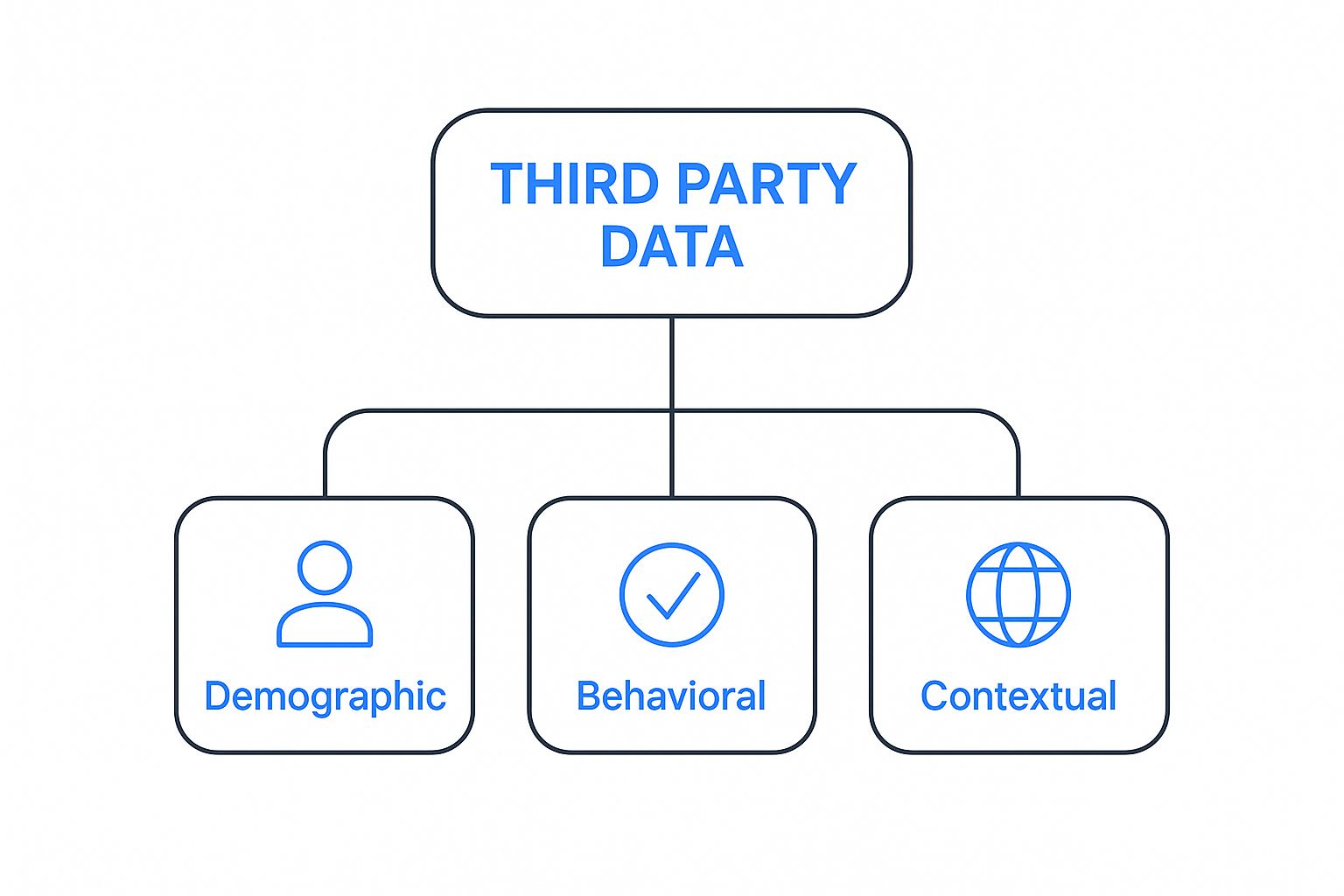When we talk about data in marketing, third-party data is the kind you buy from someone else. Think of it as purchasing insights from a data broker who has pieced together information from tons of different websites and sources to create broad audience profiles.
For years, this was the bedrock of digital advertising, letting marketers cast a wide net and reach people they’d never connected with before.
To really get what third-party data is, it helps to compare it to its much more personal cousin: first-party data. First-party data is the information you collect directly from your own audience. This is gold-standard stuff—email addresses from your newsletter sign-ups, purchase history from your store, and behavior you track on your own website. It’s incredibly accurate because it comes straight from your customers.
Third-party data, on the other hand, is a different beast entirely. It’s collected, bundled up, and sold by companies that specialize in this, often called data brokers or aggregators. These companies pull information from a massive network of sources, like public records, online surveys, and website cookies from thousands of different publishers they partner with. They then clean it up, sort it into segments, and sell it to marketers like us.
The sources are all over the place, but they usually fall into a few main buckets. Big online publishers and platforms gather user data and then sell it through data exchanges. Other dedicated data companies buy up information from multiple places, process it, and package it into neat segments that advertisers can easily target.
This whole ecosystem has been the engine of digital advertising for a long time, and it's a huge market. In fact, the global third-party data platform market was valued at around $6.3 billion in 2024 and is expected to more than double to $14.2 billion by 2033. You can explore the full market projections to see just how big this industry is.
So, why have marketers relied on it for so long? Because it does a few key things that are tough to achieve with your own first-party data. First and foremost, it provides incredible scale. It lets you reach completely new audiences—people who have never heard of your brand. By buying data segments based on interests (like "fitness enthusiasts"), demographics ("new homeowners"), or purchase intent ("in-market for a new car"), you can massively expand your prospecting campaigns.
It also helps you flesh out what you already know about your customers. You might know what someone bought from you, but third-party data can add extra layers, like their estimated household income, hobbies, or recent life events. This helps you build a much richer, more complete picture of your customer base.
This handy infographic breaks down the main types of third-party data marketers work with.

As you can see, it's all about grouping people into demographic, behavioral, and contextual buckets to create targetable audience profiles. This has been the standard for years, but as we'll get into, big changes are on the horizon for the entire data landscape.
To make it even clearer, let's break down the three main types of data marketers use. Each has its own strengths and weaknesses, and understanding the difference is key to building a solid marketing strategy.
This table gives you a quick snapshot of where each data type fits. First-party is your most valuable asset, second-party is a strategic extension, and third-party has traditionally been the go-to for casting the widest net possible.

The ground is moving under every marketer’s feet, and the epicenter of this earthquake is third party data. For years, the internet ran on an unspoken agreement fueled by third-party cookies—those little text files that followed you from site to site, powering everything from ad retargeting to cross-site audience analytics.
That engine is sputtering out. And this isn't just a small tune-up; it's a fundamental rewiring of how digital advertising works. Major web browsers are hitting the brakes on old tracking methods to put user privacy first, kicking off what many are calling the "cookiepocalypse."
The main players behind this shift are the internet's gatekeepers: the browsers. Apple’s Safari and Mozilla’s Firefox have been blocking third-party cookies for years. Now, Google is phasing them out in Chrome, the world's most popular browser. This isn't a small change—it’s a coordinated move that dismantles the very infrastructure that propped up programmatic advertising for over a decade.
This shift directly torpedoes core marketing tactics:
This isn't just about losing a tool. It's about having to rethink your entire approach to engaging with your audience. Marketers who got comfortable "renting" audiences from third-party data pools now have to get back to the fundamentals of building direct relationships with their customers.
The old way of tracking an anonymous user across the web is being replaced. The new model demands direct interaction and consent. This means marketers need to make a huge pivot in strategy and truly understand the difference between a https://www.cometly.com/post/data-driven-vs-data-informed-understanding-the-difference, where quality insights matter far more than the sheer quantity of data.
It's not just the tech companies making changes. A massive wave of privacy legislation has completely rewritten the rules for data collection. Regulations like the General Data Protection Regulation (GDPR) in Europe and the California Consumer Privacy Act (CCPA) have given people real control over their personal information. These aren't just friendly suggestions—they come with huge fines for companies that don't comply.
These laws created strict rules for how companies handle personal data, putting the focus on transparency and getting clear consent from users. For marketers using third party data, this means you're on the hook to prove the data you bought was collected legally and ethically. You can't just buy a list anymore; you have to be able to verify where it came from and that the proper consent was given.
This one-two punch from tech and legislation is forcing the entire industry to adapt. With privacy laws in full effect and major browsers like Firefox, Safari, and Chrome—which hold over 90% of the browser market share—killing off third-party cookies, marketers are scrambling to focus on first-party data. Still, even with these new challenges, 64% of marketing executives strongly believe data-driven marketing is critical.
The conclusion is unavoidable: the era of easy, massive-scale third party data is coming to an end. Adapting to this new reality isn't just a good idea—it's essential for survival.
Deciding whether to use third party data isn't a simple "yes" or "no." It requires a clear-eyed look at both its powerful advantages and its pretty serious drawbacks. The right choice really depends on your goals, your resources, and your stomach for risk.
The biggest pull of third party data has always been its sheer scale. It gives you a gateway to audiences far beyond your current reach, letting you discover and engage with entirely new market segments. This is a huge help for top-of-funnel campaigns where the goal is just to get your name out there.
It can also enrich the first-party data you already have. You might know what a customer bought from you, but third party data can add layers like their household income, interests, or job title. This turns a simple customer profile into a much more detailed persona, helping you understand their broader lifestyle and needs.
When you start applying it, the value of third party data becomes obvious. Beyond just reaching more people, it can sharpen your entire marketing approach, from how you target ads to how you analyze the market.
Here are some of the most compelling reasons marketers still lean on it:
But here’s the catch: the power of these advantages is directly tied to the quality of the data. High-quality, well-vetted third party data can be a game-changer. Its counterpart—inaccurate or old data—can send you chasing ghosts.
On the other side of the coin are some serious disadvantages that have made a lot of marketers pump the brakes on using third party data. These aren't just minor headaches; they can have real financial and reputational consequences for your brand.
The most glaring problem is data accuracy. Since you didn't collect the information yourself, you have no real way of knowing if it's any good. The data can be outdated or just plain wrong. A user who was "in-market for a new car" six months ago probably isn't anymore, but they might still be in that segment, which means you're just wasting ad spend.
Another huge issue is the lack of transparency. It’s often a "black box"—you don't know exactly how, when, or where the data was gathered. This creates major compliance risks, especially with privacy laws like GDPR and CCPA that demand clear consumer consent. Using data without proof of consent can lead to massive fines and seriously damage your brand's reputation. In fact, research shows that 73% of organizations have been hit by a significant disruption from a third-party cyber incident, showing just how real this risk is.
Finally, the whole foundation is crumbling. As browsers phase out third-party cookies, the reliability and availability of this data are dropping fast. Building a long-term strategy on something that's actively disappearing is a risky move. It also makes attributing success a massive headache, which is why having a deep understanding of different marketing attribution models is more important than ever to see what’s truly working.
To put it all in perspective, here's a quick summary of the key trade-offs you need to consider.
A summary of the key advantages and disadvantages marketers should consider before investing in third-party data sources.
Ultimately, while third party data can offer a tempting shortcut to audience growth, the risks tied to accuracy, privacy, and long-term viability are impossible to ignore. Smart marketers are weighing these factors carefully and shifting their focus toward building more reliable, transparent data strategies.
Turning raw data into actionable insights—that’s where the real magic happens. For marketers, this means feeding external data signals into your attribution models to build a complete picture of the customer journey, from the very first touchpoint to the final sale.
First-party data is fantastic for understanding what happens on your own properties, but it has a massive blind spot. It can't tell you much about the initial discovery phase that happens before a user ever clicks on your ad or visits your site. This is where third party data can fill in the crucial gaps.
Imagine a potential customer scrolling through their social media feed. They see an unbranded, awareness-focused video ad for a product like yours but don't click. A week later, intrigued by the concept, they search for the product category on Google and click a competitor's link. Finally, another week later, they remember the original brand and type your URL directly into their browser to make a purchase.
Without external data signals, your attribution model would likely credit "Direct Traffic" with 100% of the conversion value. You would have zero visibility into the social media ad that started the entire journey. This leads you to undervalue that channel and potentially cut its budget, even though it was the real catalyst.
Third party data helps connect these dots. By integrating aggregated, anonymized data, attribution platforms can identify correlations between ad exposures and eventual conversions, even without a direct click. This allows you to assign partial credit to that initial awareness play, giving you a far more accurate view of what’s truly driving growth.
The goal is to move beyond last-click attribution and understand the entire sequence of events that influenced a customer's decision. Third party data, when used correctly, provides the context needed to see the full story, not just the final chapter.
This process is essential for anyone serious about optimization. To learn more about the fundamentals, check out our complete guide on how to measure marketing attribution.
Simply dumping external data into your system isn't enough; you need a structured approach to make sure the information is both useful and reliable. Integrating third party data effectively requires careful validation and alignment with your existing first-party sources.
Here are a few key practices to follow:
Once integrated, this newly enriched dataset empowers you to make smarter, data-driven decisions that directly impact your return on investment. You can reallocate your budget with confidence, shifting funds from underperforming channels to the ones that are proven to influence conversions at the top of the funnel.
For example, your attribution platform might reveal that users exposed to a specific video campaign on Platform A are 30% more likely to convert through search ads a week later. This insight allows you to justify continued investment in that awareness campaign, even if its direct click-through conversions are low.
Ultimately, integrating third party data transforms your attribution from a simple reporting tool into a strategic decision-making engine. It connects previously invisible touchpoints, validates your marketing instincts with hard numbers, and provides a clear roadmap for scalable and profitable growth.

With all the changes from privacy regulations and browser updates, the world of third party data is on shaky ground. Smart marketers aren't just reacting—they're seeing this as a massive opportunity. The game is shifting, and the focus is turning inward to the most reliable asset any business has: its first-party data.
This isn't just a defensive move. It's a proactive step toward building a marketing engine that’s more resilient, effective, and centered around real customers. First-party data is the gold you collect yourself—every website click, purchase, form submission, and support ticket. It's accurate because it comes straight from the source.
Unlike the broad, often fuzzy segments you get from third party data, this information reflects genuine interactions with your brand. That lets you personalize and build relationships in a way aggregated data just can't match. As you map out your next move, it's crucial to understand what saying goodbye to third-party cookies really means for your strategy.
To actually use all this valuable information, a new kind of tech has become a must-have: the Customer Data Platform (CDP). Think of a CDP as the central command center for all your customer intelligence. It pulls in data from every single touchpoint—your website, CRM, app, and sales channels—and stitches it all together into one complete profile for each customer.
This unified view finally breaks down the data silos that have frustrated marketing teams for years. Instead of having separate, disconnected pools of information, a CDP gives you a persistent, 360-degree view that everyone in your organization can access.
A CDP turns scattered data points into a clear customer story. It’s the foundational tech that lets you stop renting audiences with third party data and start truly owning your customer relationships.
This shift has kicked off some serious growth in the CDP market. In 2024 alone, the market was valued at around $2.4 billion, with some estimates climbing as high as $6.24 billion. With projected annual growth rates between 24.4% and 39.9% through 2030, it's clear that businesses are scrambling to put first-party strategies at the core of their operations.
Putting your resources into a first-party data strategy isn't just about swapping out an old tool; it’s about building a competitive edge that lasts. By focusing on the data you collect directly, you unlock some powerful benefits:
Ultimately, this pivot lets you create more meaningful interactions that drive loyalty and lifetime value. While third party data gave you scale, first-party data gives you depth, precision, and a direct line to the people who matter most: your customers. This is the new cornerstone of sustainable growth.

The era of leaning on massive pools of third party data is officially over. But that doesn't mean data-driven marketing is going anywhere. Far from it. Its role is just changing in a big way.
The future belongs to marketers who can build a tough, hybrid strategy. It’s a strategy that puts high-quality, ethically sourced first-party data at its core while using external data in a much smarter, more targeted way. This isn't just about following new rules; it's a complete mindset shift.
The goal is to stop "renting" audiences from third-party data brokers and start truly "owning" your audience. That means building direct relationships founded on trust and real value, creating a competitive advantage that no one can easily copy.
So, how do you build a marketing engine that not only survives but thrives in a privacy-first world? It takes a deliberate, step-by-step plan. It’s all about creating an infrastructure that respects user consent while still giving you the insights you need to grow.
Think of the following checklist as a practical roadmap for making this happen. This isn’t a one-and-done fix, but an ongoing commitment to a more sustainable—and effective—way of connecting with customers.
Your action plan should be built on these key pillars:
The new marketing playbook isn’t about finding clever workarounds to track people. It's about creating experiences so valuable that customers want to share their information with you, turning data collection into a natural part of a positive brand relationship.
As traditional third-party data sources dry up, new technologies are stepping in to fill the gap in a much more privacy-conscious way. These methods offer a glimpse into the future of data collaboration, allowing for audience insights without ever compromising an individual's privacy.
Take data clean rooms, for instance. These are secure, neutral environments where multiple companies can pool their anonymized first-party data to find valuable insights. Neither company ever sees the other's raw data.
Imagine an airline and a hotel chain using a clean room. They could discover audience overlaps and launch powerful co-marketing campaigns without ever sharing a single customer's personal information. Getting a handle on new frameworks like this is key to maintaining a high pipeline velocity in a market that's constantly changing.
By embracing a hybrid strategy—one that combines a strong first-party foundation with these innovative, privacy-safe technologies—you can build a marketing approach that's not only compliant but also more effective and sustainable for the long haul.
As marketers stare down a future with fewer tracking signals and more privacy rules, it’s natural to have questions about third party data. Sorting out what’s legal, what’s effective, and what’s about to become obsolete is a huge challenge. Let's tackle some of the biggest questions on everyone's mind.
The short answer? Yes, but it’s a minefield. Under privacy laws like GDPR and CCPA, using third party data is only legal if you can prove that explicit, informed consent was given when the data was first collected.
Here's the catch: the burden of proof is on you, the marketer. That means you have to do some serious homework on your data providers to make sure their collection methods are clean and fully compliant. If you can't verify consent, you're opening your brand up to massive fines and a reputation nightmare.
The slow death of the third party cookie is shaking the very foundation of digital advertising. Key functions that marketers have relied on for years are either breaking or becoming far less effective. Cross-site tracking, the engine behind ad retargeting and frequency capping, is getting much harder to pull off.
Building detailed audience profiles for prospecting campaigns is also a huge challenge now. Without cookies to stitch together a user's browsing behavior across the web, those rich profiles start to look pretty thin. And any attribution model that depends on tracking a user’s journey across multiple sites is losing a ton of accuracy. The only way forward is to lean into first-party data, contextual advertising, and new privacy-first tech.
The core challenge is a loss of signal. Without cookies, the digital "footprints" that advertisers have followed for years are disappearing, forcing a return to strategies built on direct customer relationships and contextual relevance rather than behavioral tracking.
This question comes up all the time, and the difference is pretty simple when you boil it down. It all comes down to the type of data they handle and what they're built to do. A Data Management Platform (DMP) is an advertiser's tool, first and foremost. It mainly deals with anonymous, third party data like cookie IDs and is designed to build audience segments for short-term ad campaigns.
A Customer Data Platform (CDP), on the other hand, is all about your persistent, first-party customer data. We're talking about personally identifiable information (PII) like names, email addresses, and purchase history. A CDP creates a single, unified profile for each customer that lasts over time. This rich profile isn't just for ads—it can be used across every marketing channel, from email campaigns to your customer service desk.
Ready to master your marketing attribution with data you can trust? Cometly provides the tools to unify your customer journey, track every touchpoint with precision, and optimize your ad spend for maximum ROI. Start tracking what truly drives revenue with Cometly today.
Learn how Cometly can help you pinpoint channels driving revenue.
.svg)
Network with the top performance marketers in the industry